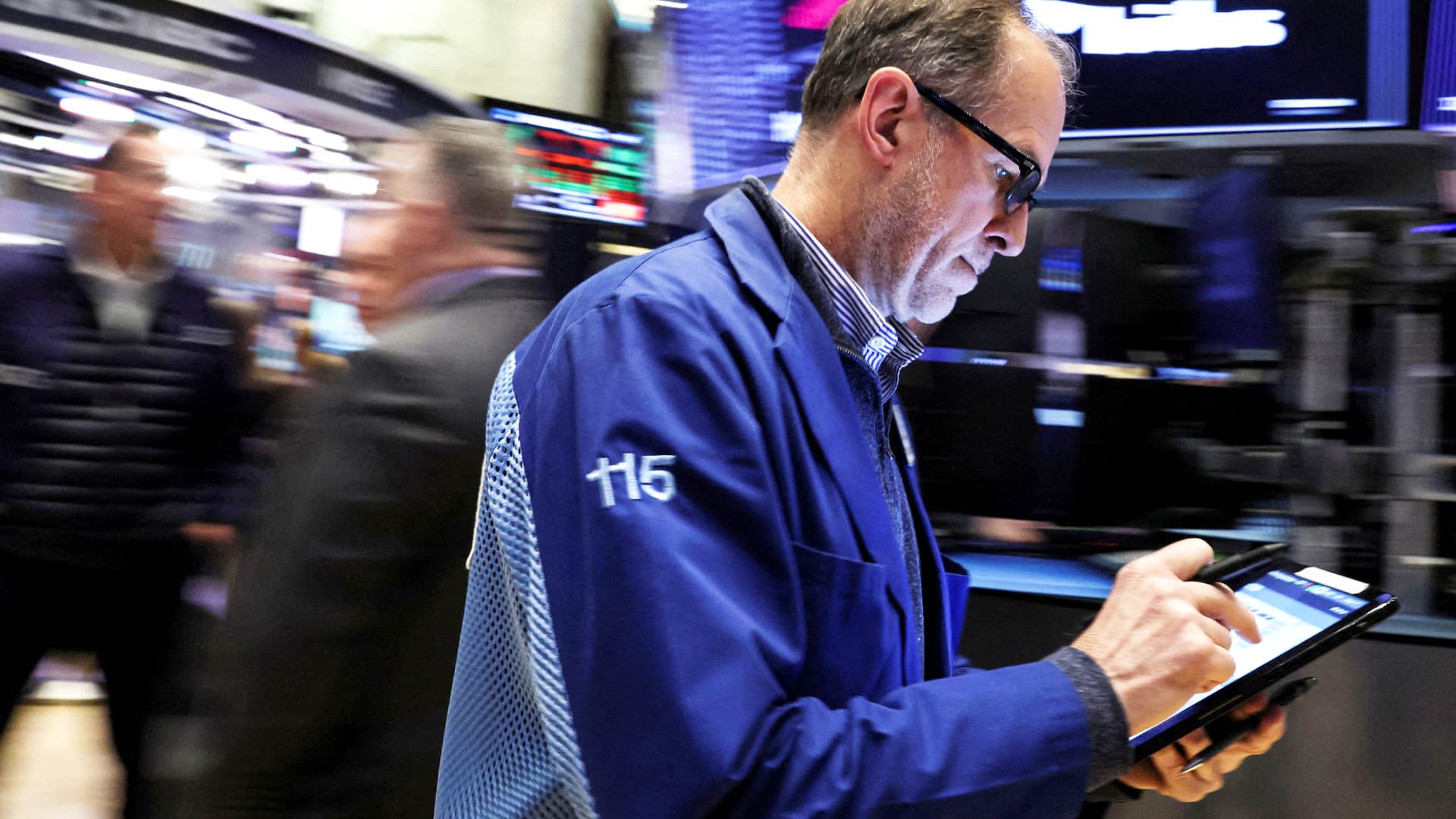
Here are the most important news, trends and analysis that investors need to start their trading day:
1. Stock futures jump as investors process key inflation report
Traders work on the floor of the New York Stock Exchange (NYSE) in New York, March 29, 2022.
Brendan McDermid | Reuters
Stock futures jumped Tuesday morning as Wall Street digested a key inflation report. A day earlier, all three major U.S. equity indexes pulled back as the yield on the 10-year Treasury note touched a three-year high and intensified concerns about an economic slowdown. The Dow Jones Industrial Average on Monday declined 413 points, or 1.19%, while the S&P 500 slid 1.69%. The Nasdaq Composite — home to many growth stocks that are more sensitive to higher interest rates — dropped 2.18%.
The tech-heavy Nasdaq is down about 5.7% month to date. The S&P 500 has dropped 2.6%, while the blue chip Dow has fallen roughly 1.1%.
2. 10-year Treasury yield reaches its highest level since December 2018
The 10-year U.S. Treasury yield traded at its highest point since December 2018 on Tuesday morning, reaching 2.82% before retreating somewhat to 2.798%. The yield fell further to 2.73% after the Labor Department released the March consumer price index report at 8:30 a.m. ET.
Treasury yields, which move inversely to prices, have climbed rapidly in recent weeks. As recently as March 7, the 10-year U.S. Treasury yield was below 1.7%. However, yields have surged as the bond market braces for more aggressive policy tightening from the Federal Reserve. In March, the U.S. central bank raised interest rates for the first time in more than three years, and an even larger hike is anticipated at its May meeting.
3. March CPI shows hottest inflation since 1981
A person shops for groceries at Lincoln Market on March 10, 2022 in the Prospect Lefferts Garden neighborhood of Brooklyn borough in New York City.
Michael M. Santiago | Getty Images
The consumer price index for March increased 8.5% on an annual basis, the largest year-over-year jump since December 1981, the Labor Department said Tuesday. That’s slightly above Dow Jones estimates of 8.4%. Core CPI, which excludes food and energy, matched expectations with an 6.5% increase.
The CPI tracks a wide-ranging collection of goods and services and has for months been running at its hottest levels in decades. The Fed’s policy tightening is being done in an attempt to tamp down that historically high inflation.
Energy prices rose significantly in March’s report, up 11% month over month and 32% year over year. Economists had warned about that large surge due to the major oil price spike in early March related to the Russia-Ukraine war. Shelter costs increased 0.5% compared with the prior month and 5% on an annual basis.
4. U.S. monitoring claims of possible Russian chemical attack in Ukraine
Pentagon Press Secretary John Kirby speaks during a news briefing at the Pentagon April 11, 2022 in Arlington, Virginia.
Alex Wong | Getty Images
The U.S. is monitoring unconfirmed reports of a potential Russian chemical weapons attack in the Ukrainian port city of Mariupol, Pentagon press secretary John Kirby said Monday night. While Kirby indicated the U.S. has not verified the accounts, he said they are “deeply concerning.” The unconfirmed reports also are “reflective of concerns that we have had about Russia’s potential to use a variety of riot control agents, including tear gas mixed with chemical agents, in Ukraine,” Kirby said in a statement.
British Foreign Secretary Liz Truss said the U.K. is working to verify details of the possible attack, which originally was a Telegram message posted by an ultra-nationalist part of the Ukrainian National Guard called the Azov Regiment. The message claimed Russian forces used “a poisonous substance of unknown origin.”
5. Shanghai’s weekslong lockdown eases for some residents
The metropolis of Shanghai, where many foreign businesses are located, entered a two-part lockdown this week as municipal authorities sought to control an outbreak in China’s worst Covid wave in two years.
Hector Retamal | Afp | Getty Images
Shanghai’s Covid lockdowns eased for some residents Tuesday, more than two weeks after the strict public health protocols were put in place as coronavirus infections rose. Local media reported nearly 5 million people live in parts of Shanghai where restrictions are being relaxed because no new cases were detected in that area for at least two weeks. While those residents are able to leave their homes, Reuters reported there was some confusion about just how freely they could move.
Shanghai is China’s largest city, home to about 26 million people. Concerns about the humanitarian and economic impact of the strict lockdowns has intensified in recent days. On Monday, the U.S. State Department told all nonemergency government staff and their family members in Shanghai to leave the city.
— Sign up now for the CNBC Investing Club to follow Jim Cramer’s every stock move. Follow the broader market action like a pro on CNBC Pro.







